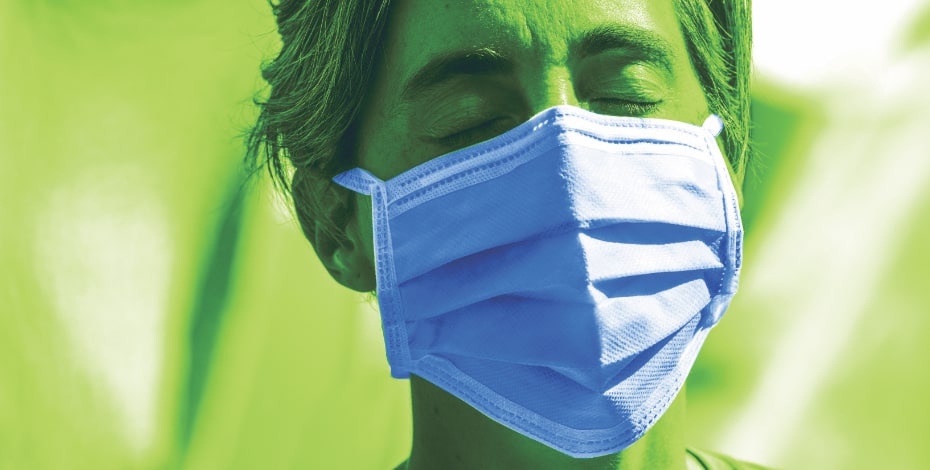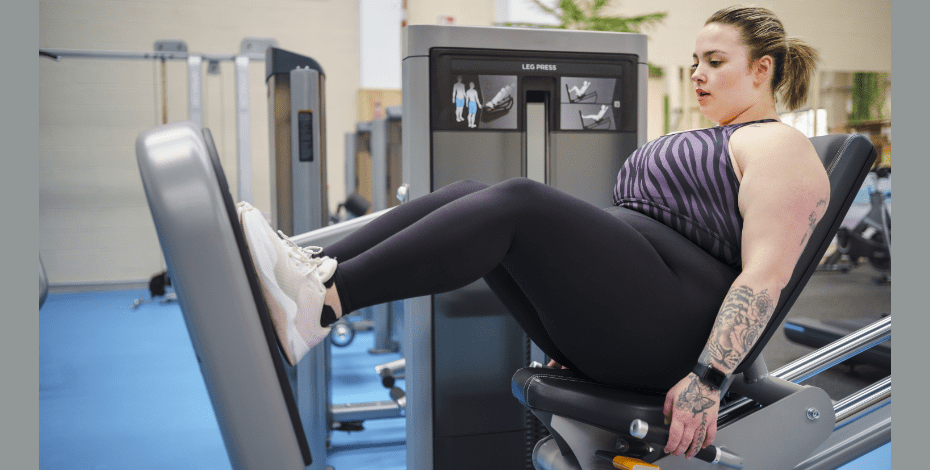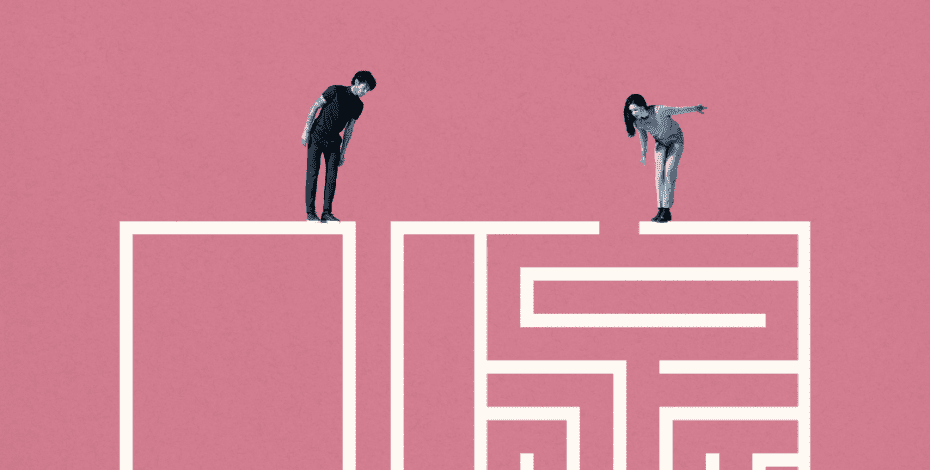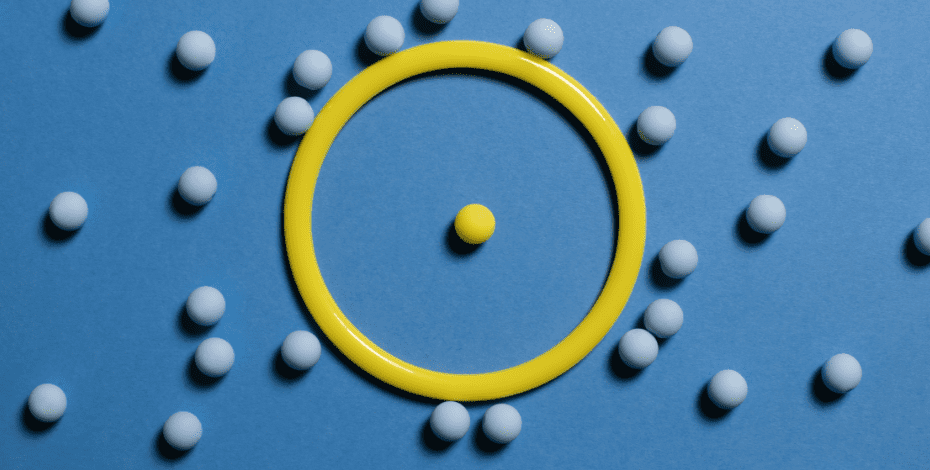
Coronavirus care, in and out of the hospital

Physiotherapists are there when patients with COVID-19 need acute care, and they’re there when survivors need rehabilitation for ongoing symptoms. Zachary Attard and Meredith King answer some questions about physiotherapy management in the acute hospital and community settings, respectively.
Acute ward management for COVID-19
What has your role been in the management of COVID-19?
I have acted as the physiotherapist on the COVID- dedicated ward at Austin Health in Melbourne.
In my role, I have undertaken assessment, then management and progression of patients’ mobility and endurance, as well as optimising their overall functioning.
In addition to the rehabilitative management, I have provided education and intervention for pre-existing or symptom-induced respiratory complications that fall within the scope of physiotherapy management (airway clearance, dyspnoea management, volume restoration techniques).
Being the single allied health representative on the ward, I have also assisted the other disciplines (speech therapy, dietetics, occupational therapy and social work) to manage their interactions and interventions with COVID-positive patients.
What planning did you and your team undertake at the start of the pandemic?
Modelling was performed to determine predicted numbers and staffing requirements to manage the expected caseload.
Thresholds were identified to determine at which point extra staff members would be required to integrate into the team.
Following this, the appointment of a COVID-specific allied health team was undertaken.
This involved training or retraining of suitable staff in key areas such as oxygen therapy, strategies for exertional dyspnoea, exercise principles in ICU-acquired weakness and hospital-acquired deconditioning.
This training ensured competency when managing the expected patient presentations, as based on the overseas experience.
What changes to your workforce occurred?
A redesign of the allied health model (within this specific ward) was undertaken to ensure that patients still received timely and efficient delivery of services.
People were reassigned to the COVID-specific allied health team, and their primary clinical focus was management of the COVID-positive patients.
This team was managed by a team leader who guided a single trained representative, known as the interdisciplinary practitioner (which in our organisation was myself), to engage in the assessment and interventions with the patient on behalf of allied health.
In this role, I underwent competency training in some key core capabilities of each allied health discipline to enable me to identify/recognise the need for discipline-specific input.
Using this training, I remotely collaborate with discipline-specific allied health team members via video and telehealth to conduct the more complex interventions and assessments.
Within our organisation, the trained interdisciplinary practitioner was selected from the physiotherapy department.
From the literature, and experiences being shared from overseas, it was reasoned that the primary patient problems, especially in the severely affected patients, would likely be centred on acutely developed weakness and loss of respiratory reserve.
It was decided that physiotherapy had the most scope and expansive skillset to lead the management of these issues within an allied health space, and therefore should be the face-to-face patient representative from allied health on the ward.
How have you managed the patients recovering from COVID-19 on the acute ward?
Our hospital has a dedicated COVID ward where all patients who test positive are isolated in single rooms.
All staff on the wards wear full personal protective equipment at all times, with extra precaution taken when a staff member enters a patient’s room.
The ward has dedicated medical, nursing and allied health teams.
Isolation in restricted spaces has presented some limitations to the level of care able to be provided, as exercising a patient to high capacity in the confined space of a single room presents challenges.
Outcome measures and ongoing reassessment has been challenging for the same reasons.
The approach to management of these patients has been based more around functional optimisation, use of global indicators and utilising previously validated measures for similar case presentations (acute respiratory distress syndrome (ARDS), ICU long-stayers) due to the paucity of established practices in this field.
A unique approach to management, adopted in the setting of emerging anecdotal evidence and its alignment with similar presentations (in ARDS), we have been encouraging those patients that are spontaneously breathing and requiring oxygen support to spend periods of their bedrest in prone position.
Education for this has been provided by the physiotherapy team due to our expertise in positioning and mobility.
Ideally, the task is managed independently by the patient for comfort sake, but in those willing to trial, allied health and nursing can assist if needed (due to the increased availability of staff on the ward).
Have you made any changes in the way you work with them compared to your usual workload? Also, are you minimising face-to-face contact, are other allied health not seeing these patients etc?
The redesigning of the allied health model has enabled us to utilise technology and a single trained individual to undertake the face-to face interactions with patients while ensuring they still receive the required allied health services.
This ensures minimal traffic on the ward at any given time, as well as reducing the total number of staff exposed to the ward environment.
The interdisciplinary practitioner is dedicated to the ward to ensure equitable provision of services to the patients in comparison to other wards, and prevent any risks of cross contamination while the remote clinicians absorbed this duty into their daily caseload.
What are the key impairments that you are noticing with these patients?
Respiratory-related symptoms and problems for physiotherapy management have been minimal within our population.
Interestingly, within our small patient sample, those that have required mechanical ventilation and admission to ICU have not needed ongoing respiratory or oxygen support once stable and admitted to a ward setting.
Tachycardia and tachypnea have been common clinical impairments in the ward environment, and these are monitored closely (in addition to oxygen saturations), with precautions taken.
However, airway clearance and ventilation have been managed by the patient under minimal, if any, guidance or assistance.
Use of the Borg dyspnoea scale has been adopted to determine breathlessness.
Weakness, reduced balance, and reduced exercise tolerance are the common and key impairments witnessed within these patients.
Symptoms affecting desire and capability to mobilise, and exertional dyspnoea create an environment that fosters sedentary behaviour, leading to the aforementioned impairments.
Holistically speaking, nausea and altered taste are also commonly reported in COVID-positive patients, affecting nutritional intake and therefore ability to regenerate muscle mass and provide energy to engage in exercise.
Those that require ICU admission have the additional complications associated with prolonged mechanical ventilation and sedation in delirium risk and swallowing deficits that can provide barriers to engagement in therapy.
Pain and dizziness, related to the illness, are not common and if present have typically been indicative of other issues.
Are there any differences compared to your usual respiratory patients?
Given our vulnerable patients have shown greater compliance with recommendations regarding social isolation and distancing, our organisation has experienced a greater majority of admissions of previously healthy individuals. This means that, in many cases, they are not burdened by chronic co-morbid conditions when they become infected.
In addition to this, the majority of our cases have had no underlying respiratory conditions that leave their lung parenchyma and respiratory mechanics compromised prior to infection.
This by no means determines the severity of their symptoms, but has meant that issues like sputum retention and volume loss have been minimal in comparison with typical respiratory patients.
Despite the severe cases that require ICU admission and ventilation, following a clinical picture similar to that of ARDS, their respiratory recovery, once weaned from ventilation and extubated, has been focused around restoration of the musculoskeletal system.
This creates a shift in the physiotherapy management of these patients (that have essentially presented with a primary respiratory illness) away from some traditional respiratory interventions towards a primary focus on exercise, targeted to increase respiratory reserve and muscular endurance.
Have there been any challenges in discharge planning for this group? What has been your process to get patients discharged and followed up in the community?
From a wider allied health perspective, a challenge has been managing the cohort of patients who require family support to manage their daily lives.
Coming up with alternative discharge locations and arrangements to provide that support, but ensure the patients can still isolate, has required creative thinking and at times has resulted in delays to discharge that would not normally be present in a non-COVID situation.
Our approach has slightly altered in regard to determining a patient discharge.
In standard times, patients might be sent home at a reduced (but still capable) level of function with extensive home supports and follow-up therapy options organised.
During the pandemic, a conscious effort has been made (where possible) to fully maximise a patient’s independence in the hospital setting, even if that has meant slightly extending the patient’s length of stay (within acceptable parameters).
Medical teams have made the final call in regard to a patient’s eligibility to discharge from hospital (in consultation with the Department of Health and Human Services, DHHS), but safety and independence (within reason) remain paramount to a physiotherapy criterion for discharge and have not been compromised to expedite discharge.
Extensive education to both the patient and family has been provided prior to discharge, regarding goals and expectations/trajectory to return to baseline exercise.
This has been tailored to the individual patient needs, and their perceived level of wellness at time of discharge.
Patients who have required ongoing rehabilitation to achieve a return-to-baseline mobility were offered the opportunity in subacute facilities once in compliance with DHHS protocols.
In combination with education, follow-up therapy plans are created with an acknowledgement that access to ideal equipment and environments would be restricted.
Consequently suggestions for best possible substitutes are made (use of household objects as weights, prescribing exercises using body weight etc.). In addition, for those that required closer monitoring of their progress, telehealth has been used as a means to regularly engage with the patients.
Our hospital has maintained a domiciliary physiotherapy service for those that cannot manage telehealth but require ongoing therapy, but this has been used sparingly as other options have sufficed.
>> Zachary Attard, APAM, is a Grade 2 physiotherapist working at a tertiary hospital in Melbourne. He has spent time working in intensive care, as a member of the Victorian Respiratory Support Service and most recently within the General Medicine stream prior to being seconded to work in the COVID-19 response.

Rehabilitation after COVID-19
What has your role been in the rehabilitation of people after COVID-19?
The service I work for, the Chronic Disease Community Rehabilitation Service, covers the Northern Sydney area, which was one of the early sites of community transmission of COVID-19 in March.
Our team has been providing rehabilitation for COVID-19 survivors that have ongoing symptoms.
What has the rehabilitation pathway looked like in your area?
It has varied depending on the patient’s needs. Some patients have been referred to pulmonary rehabilitation directly from the acute hospital while others have been seen by our hospital-in-the-home service first.
We are also now seeing a few patients referred from their general practitioners who may have only had very mild disease initially but are suffering with persistent dyspnoea and fatigue a few months on.
How is the rehabilitation structured?
For those being seen by the acute hospital physiotherapists, patients will start with some basic exercises such as sit to stand, heel raises and light upper limb strengthening.
The patients also try to complete outcome measures including five sit to stand, one minute sit to stand and marching on the spot (to assess oxygen and heart rate response to exertion) and record some details about their main symptoms.
In our area, patients can be discharged home while still COVID-19 positive and complete the rest of their quarantine period at home, so we have needed to modify how outcome measures can be done in the acute setting.
If our hospital-in-the-home service is involved, physiotherapists will do home visits and progress the home exercise program as indicated and provide the patient with a portable pulse oximeter to use for monitoring.
Once pulmonary rehabilitation starts, we have been doing weekly video calls with the patients and progressing their exercise routine each time as appropriate.
We complete outcome measures (sit to stand tests, fatigue severity scale and a symptom scale) at the start of the program and every four weeks after that to monitor progress.
Some patients have required home visits to help give them extra confidence with some of their exercises, but predominantly we are providing telehealth consultations for all patients with our service at present.
Rehabilitation for most patients has started with endurance exercise such as walking or stationary bike, aiming for a slight–moderate level of breathlessness initially while the patients get used to the increased activity.
We also prescribe some functional leg strengthening and some unsupported arm exercises.
Depending on the patient’s needs, we have also included inspiratory muscle training, breathing control practice, gait retraining and balance practice.
We have mostly started with three days per week and progressed from there depending on fatigue and dyspnoea; for some patients we have split their exercises into very small intervals.
How are people recovering from COVID-19 different from the usual pulmonary rehabilitation cohort?
While symptomatically there is some crossover with dyspnoea on exertion, fatigue, and loss of muscle strength, it is important to recognise that this group are different to our usual group.
In conditions such as chronic obstructive pulmonary disease, there is good evidence around the role of pulmonary rehabilitation after an exacerbation; however, in COVID-19 we still do not know much about rehabilitation safety or how to identify who will benefit most from rehabilitation.
One of our patients did have a pulmonary embolus about 10 weeks after his initial infection and by that point was already returning to work and trying to get back to all his usual activities.
So we are being very cautious around monitoring changes in symptoms for this group as we don’t want to miss a warning sign for an adverse event, as well as encouraging the patients to speak up if something changes.
It is also difficult to predict the amount of natural recovery some patients may have and whether they may not have even required rehabilitation despite being symptomatic in the early stages.
Thankfully, our service has had capacity to accept all of the COVID-19 referrals we have received but it would certainly be more difficult to identify who would benefit most from rehabilitation if deciding at the point of hospital discharge.
Some of our patients actually had a very mild illness to begin with but have still struggled to recover.
Secondly, these patients have not had a long history with a chronic lung disease so these symptoms and changes in their function have been very sudden and highly distressing.
Some of our patients have now had lung function tests done and despite their results being only slightly outside of the normal range, it’s important to remember that this has happened essentially overnight.
This can mean their symptoms are much more pronounced as their body attempts to compensate.
There are huge adjustments required when returning home and trying to slowly get back to their usual activities.
It can be more challenging when it causes changes to how the patient’s household may function, and our patients who have had dependant family members or children have certainly struggled with this when first at home.
Another key difference is that because there may be such a large drop in function while unwell, it means the trajectory of improvement can be large, which creates challenges for the treating clinicians.
One of our first patients progressed from being breathless walking around the house to doing a high-intensity program over a six-week period, so it definitely keeps you on your toes.
It is important to remember the patient’s baseline level of function in your rehabilitation planning as well, as they are often significantly stronger than our usual cohort so their goals may require more strength and endurance than we usually aim for.
What are some other challenges you have noticed?
It is a difficult time to be completing your rehabilitation due to all the other restrictions around.
For some of our patients, their usual activities like social sports, gym etc have not been running for several months so it might be harder for them to find a good routine for their exercises.
Also, other stressors in the home, such as remote learning for children and changes to community services, have made it harder for people who have dependant family members.
We actually noticed that for some people, their symptom severity has increased once restrictions eased as they hadn’t been in situations that challenged them while in home isolation.
What are the main symptoms that you are seeing?
There are the more obvious ones like dyspnoea while doing endurance activities or household tasks like gardening and cleaning.
Also, significant physical and mental fatigue. Some other symptoms that have been apparent are laryngeal sensitivity, dyspnoea with long conversations and dysfunctional breathing patterns when fatigued, and reductions in memory recall.
Has rehabilitation worked?
Yes, all our participants have had significant improvements in their muscle strength, endurance and ability to complete their activities of daily living.
Fatigue seems to be slower to improve but we have noticed that our patients are able to do more before fatigue hits. We have also seen some improvements in memory.
What is the take-home message?
If you are treating someone who is recovering from COVID-19, a thorough assessment will help you identify what ‘treatable traits’ are going to be relevant for this person so you can develop your plan to address these issues.
There is not going to be one perfect solution for these patients, and even people who originally had mild symptoms may have rehabilitation needs after their acute illness.
It is likely over time that people recovering from COVID-19 will seek out their local physiotherapist for support, particularly in areas where comprehensive pulmonary rehabilitation may not be available.
As physiotherapists, we have strong patient-assessment skills which should allow you to find the ‘treatable traits’ but don’t be afraid to refer the person for further medical or specialised pulmonary rehabilitation review if something doesn’t seem right.
The APA CRPA Facebook group is also a great avenue to ‘phone a friend’ if you need some guidance.
>> Meredith King, APAM, is the current national chairperson for the APA Cardiorespiratory Group. Clinically she works as a senior physiotherapist in the Chronic Disease Community Rehabilitation Service (Pulmonary and Heart Failure Rehabilitation) in Northern Sydney.
© Copyright 2024 by Australian Physiotherapy Association. All rights reserved.






